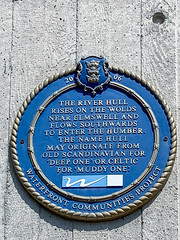River Hull
Commemorated on 1 plaque
The River Hull rises on the Wolds near Elmswell and flows southwards to enter the Humber. The name Hull may orginate from old Scandinavian for 'Deep One' or celtic for 'Muddy One'.
Tidal Barrage, Hull, United Kingdom where it was

